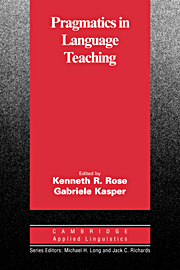Book contents
- Frontmatter
- Contents
- List of contributors
- Series editors' preface
- Preface
- Chapter 1 Pragmatics in language teaching
- I THEORETICAL AND EMPIRICAL BACKGROUND
- Chapter 2 Evaluating the empirical evidence: Grounds for instruction in pragmatics?
- Chapter 3 Classroom research on interlanguage pragmatics
- II ISSUES IN CLASSROOM-BASED LEARNING OF PRAGMATICS
- III THE EFFECTS OF INSTRUCTION IN PRAGMATICS
- IV THE ASSESSMENT OF PRAGMATIC ABILITY
- References
- Name index
- Subject index
Chapter 2 - Evaluating the empirical evidence: Grounds for instruction in pragmatics?
Published online by Cambridge University Press: 05 October 2012
- Frontmatter
- Contents
- List of contributors
- Series editors' preface
- Preface
- Chapter 1 Pragmatics in language teaching
- I THEORETICAL AND EMPIRICAL BACKGROUND
- Chapter 2 Evaluating the empirical evidence: Grounds for instruction in pragmatics?
- Chapter 3 Classroom research on interlanguage pragmatics
- II ISSUES IN CLASSROOM-BASED LEARNING OF PRAGMATICS
- III THE EFFECTS OF INSTRUCTION IN PRAGMATICS
- IV THE ASSESSMENT OF PRAGMATIC ABILITY
- References
- Name index
- Subject index
Summary
Introduction
Everyone who works with a second or foreign language, whether learners, teachers, or researchers, knows a funny story about crosscultural pragmatics – or maybe the stories are really not that funny. From the perspective of the speaker, they may be about feeling silly, helpless, or rude; from the perspective of the listener, they may be about feeling confused, insulted, or angry. Anecdotal evidence inspires us to say that we ought to teach, as one of our ESL students said, the “secret rules” of language. Much research has gone into identifying how speakers of various languages realize speech acts, take turns, and use silence, for example, so that what our student called the secret rules are not unknown; and even if our knowledge is incomplete at this stage, could it form the basis of an informed pedagogy? In other words, is there empirical evidence that warrants the development and implementation of a pedagogy of pragmatics in second and foreign language instruction? In this chapter, I will review the empirical evidence that shows that native speakers (NSs) and nonnative speakers (NNSs) of a given target language appear to have different systems of pragmatics, discuss the factors that influence the development of L2 pragmatics systems, and then address the question of whether differences in pragmatics systems warrant instructional treatment.
The evidence
This review adopts a speech act perspective. Although it is not the only way of viewing pragmatics, speech act research has been well represented in crosscultural and interlanguage pragmatics research, and provides a common analytic framework which facilitates comparison across studies.
Information
- Type
- Chapter
- Information
- Pragmatics in Language Teaching , pp. 13 - 32Publisher: Cambridge University PressPrint publication year: 2001
Accessibility standard: Unknown
Why this information is here
This section outlines the accessibility features of this content - including support for screen readers, full keyboard navigation and high-contrast display options. This may not be relevant for you.Accessibility Information
- 161
- Cited by
